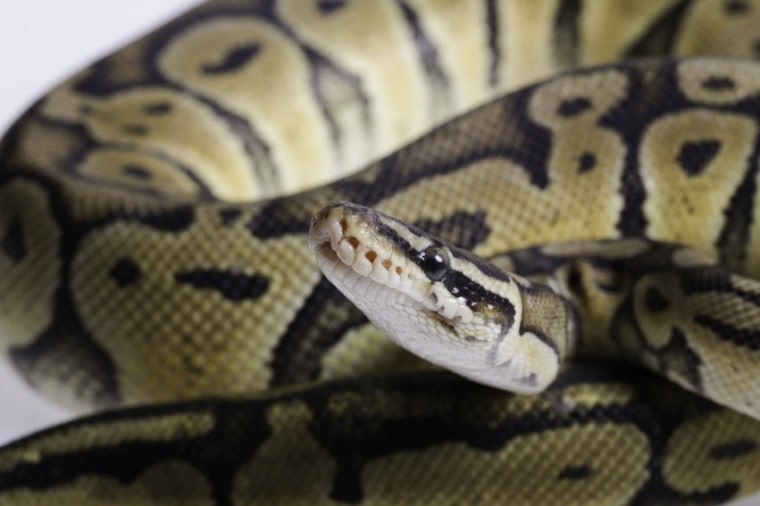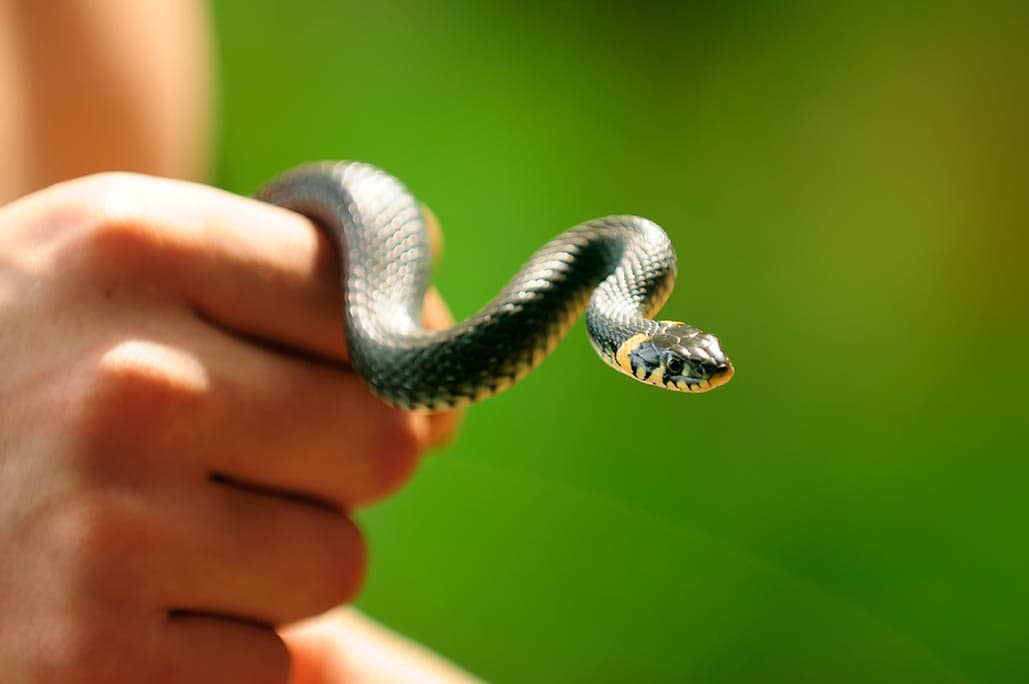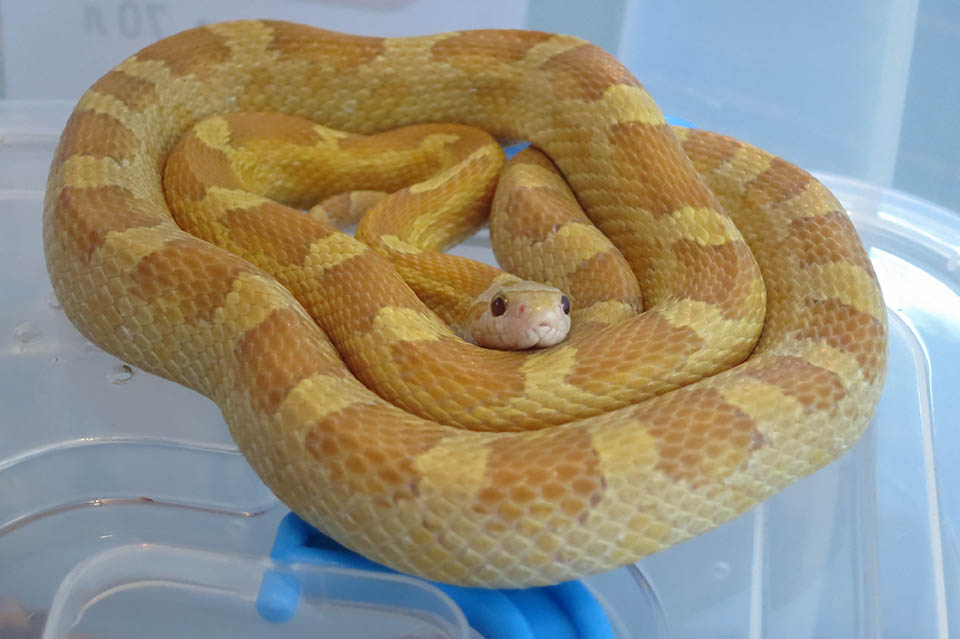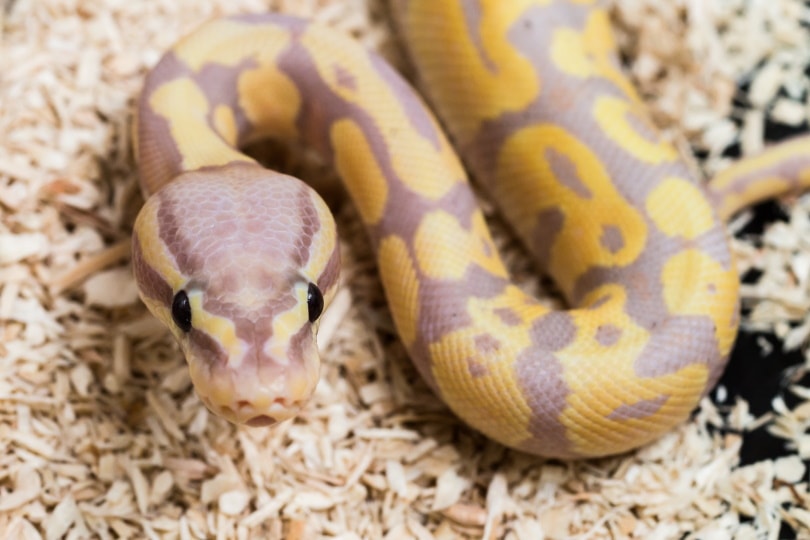
Ball pythons are one of the most popular types of pet snakes. They are shy, friendly, and relatively easy to care for. The calico ball python morph, like all other snake morphs, is created by isolating certain genes during breeding. This has led to the creation of thousands of different color patterns in ball pythons and other pet snakes.
If you are considering adding a snake to your family, ball pythons are generally considered a great choice for beginners. Read on to learn more about them.
 Quick Facts about Calico Ball Pythons
Quick Facts about Calico Ball Pythons
| Species Name: | Python regius |
| Common Name: | Ball Python |
| Care Level: | Low to Medium |
| Lifespan: | Up to 30 years |
| Adult Size: | 4 to 5 feet |
| Diet: | Mice, rats, gerbils |
| Minimum Tank Size: | 120-gallon for adult |
| Temperature & Humidity: | 75 to 85 degrees Fahrenheit 40% to 60% humidity |
Do Calico Ball Pythons Make Good Pets?
Yes, calico ball pythons do make good pets. The calico ball python is simply a ball python with a specific color pattern. These snakes are typically recommended as a smart choice for new reptile owners. They are docile, shy, and pretty easy to care for.
Another nice feature of ball pythons is the fact that they don’t get too large. This makes it possible to keep them comfortably in a large tank. They also are very adaptable and thrive in captivity.

Appearance
The calico ball python morph pattern resembles that of a calico cat. They have a white underbelly. The top of the snake is brown, with orange or yellow blotches. Typically these snakes will be between 3 to 4 feet in length when fully grown, although occasionally they may reach 5 feet.
The body of a ball python is fairly stocky and they have a small head relative to the rest of their body.
How to Take Care of Calico Ball Pythons
One reason ball pythons are such popular pets is that they are relatively easy to care for. Outside of some specific needs for temperature and tank conditions, there isn’t much a snake owner needs to do to keep their pet happy and healthy.
Habitat, Tank Conditions & Setup
Tank
If you get a ball python when it is a baby, you can start with a small 10-gallon tank. However, as the snake grows, so too should its habitat size. Adult ball pythons will require a minimum of a 120-gallon tank.
The tank should be thoroughly cleaned and disinfected every week. This will prevent your snake from getting ill from bacteria in the tank. The substrate should also be changed out weekly.
Finally, you need to have a hide box for your python to hide in and a decorative branch or two, as sometimes these snakes like to climb a branch and survey their surroundings. If you are using a glass tank, covering three of the sides with craft paper will help your snake feel more secure.
Lighting
Ball pythons should have about 8 to 12 hours of light daily. At night, you should provide them with infrared light. They will sleep throughout most of the day and do their hunting at night.
Heating (Temperature & Humidity)
The ambient temperature for a ball python should be between 80 to 85 degrees Fahrenheit during the day and 75 to 80 degrees Fahrenheit at night. They should also have a basking spot where the temperature is kept between 90 to 95 degrees.
Humidity levels should be maintained between 40% to 60%. Higher levels of humidity should be maintained during shedding periods as it will make shedding easier for the snake.
Substrate
Cypress bark, fir bark, or AstroTurf all make good choices for a ball python tank substrate. You should not use cedar or pine as they can be toxic to your snake.
Tank Recommendations
| Tank Type: | 120-gallon tank |
| Lighting: | UVB lighting for 12 hours, infrared at night |
| Heating: | Heat lamp to maintain temperature |
| Best Substrate: | Cypress or fir shavings |
Feeding Your Calico Ball Python
Calico ball pythons typically eat rodents. Small mice, rats, or gerbils are popular choices. Juvenile snakes should be fed once per week, while adults should be fed about every 7 to 10 days.
While snakes hunt for prey in the wild, it’s better to feed captive snakes dead rodents to protect them. Live prey can harm your snake.
Ball pythons are prone to periods of not eating. Normally, this is fine. However, if you notice that your snake is losing weight, you’ll want to take it to the vet to ensure that it is healthy.
Finally, you should always have a large bowl of fresh water in the tank. Change the water every other day to prevent bacteria build-up.
Diet Summary
| Fruits | 0% of diet |
| Insects | 0% of diet |
| Meat | 100% of diet – small/medium-sized rodents |
| Supplements Required | None |

Keeping Your Calico Ball Python Healthy
You should make sure you are only getting your pet from a breeder or pet store that sells snakes bred in captivity. These snakes will suffer from fewer health issues than those captured from the wild. Ball pythons are generally pretty healthy, but there are some health problems they can suffer from.
Common Health Issues
Lifespan
Ball pythons can live for up to 30 years if they are kept in a clean, stable environment and properly cared for. The typical lifespan is between 20 to 30 years so expect a pet you’ll have to take care of for a long time if you decide to get a ball python.
Breeding
It is not recommended that amateurs breed ball pythons on their own. This is best left to professionals. The process is complicated and requires specific temperatures, conditions, and timing. If everything is not done correctly, your snake can become stressed, ill, or even die.
Are Calico Ball Pythons Friendly? Our Handling Advice
Calico ball pythons are very friendly compared to many types of snakes. You can handle them if you follow a few simple guidelines. After bringing home a new snake, you should leave it alone for at least 2 weeks so it has time to adapt to a new environment.
After the initial 2-week period, it’s fine to handle your ball python once or twice per week. Always wash your hands first and use hand sanitizer. This will help prevent biting. Don’t squeeze them too tightly. Also, if your snake tries to curl up in a ball while you are handling it, you should put it back in the tank. This means the snake is stressed and wants to be left alone.
Two times you should never handle your snake are within 48 hours of its meals and during the shedding period.
Shedding: What to Expect
Ball pythons will shed their skin about every 4 to 6 weeks. You’ll notice its eyes turning blue or opaque. Its scales will also start to loosen.
If it appears that your snake is having trouble shedding its skin, check the humidity levels in the tank. Low humidity can make it more difficult, painful, and stressful for the snake. You should also avoid handling your snake during this time.
How Much Do Calico Ball Pythons Cost?
The price of ball pythons is dependent on the morph or color pattern you are looking for. A calico is somewhat rare, so you should expect to spend between $150 to $250 for a snake. Make sure you are only buying snakes that have been bred in captivity, not wild-caught pythons. Pythons that aren’t captive-bred struggle in captivity.
Care Guide Summary

Final Thoughts
Calico ball pythons are a beautiful morph. They are also relatively low-maintenance pets that require little outside of a clean tank and weekly feeding. If you’ve always wanted to try your hand at reptile ownership, a ball python is a great way to start!
Featured Image Credit: kirilldz, Shutterstock








